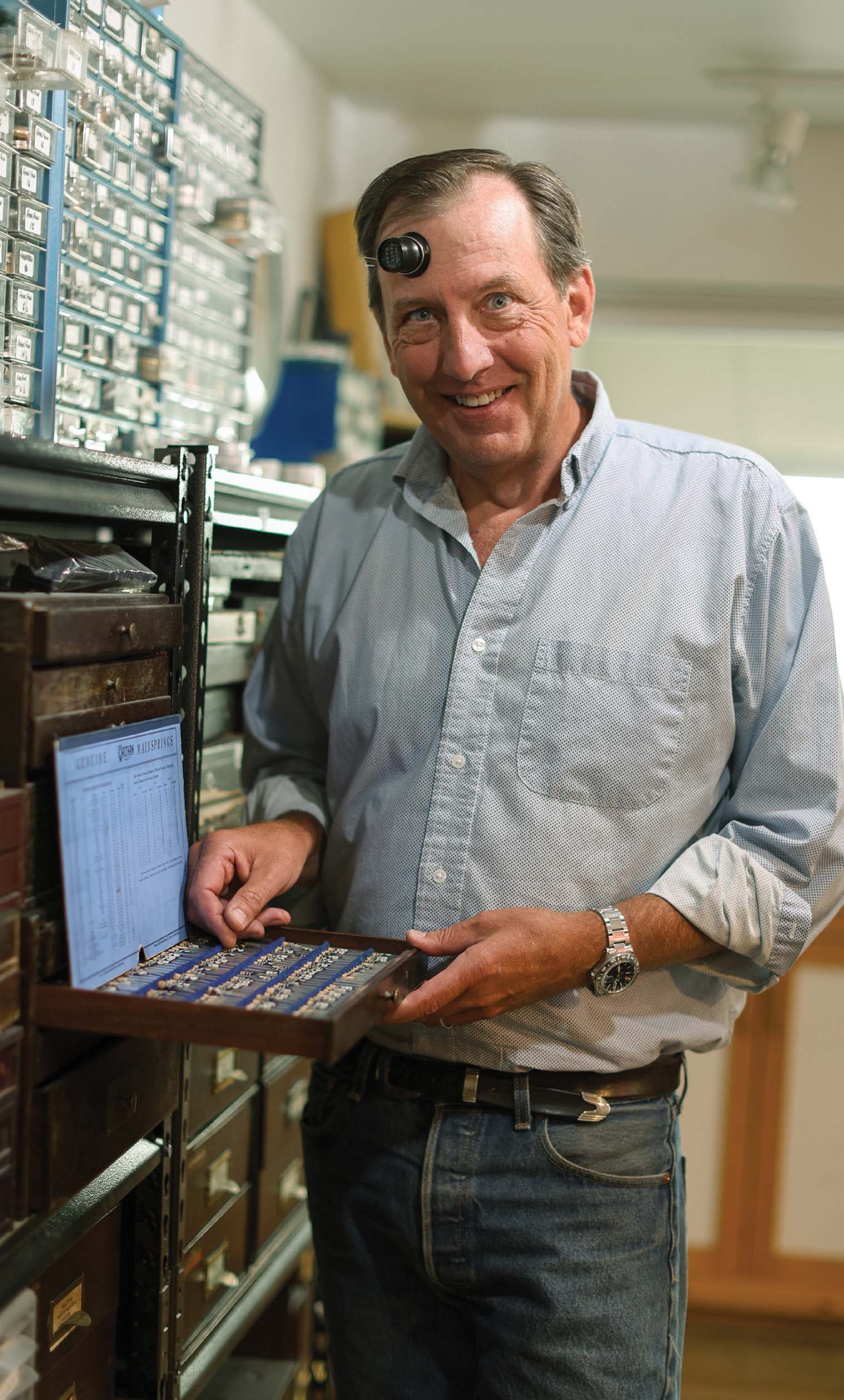
25 Sep Local Knowledge: Winding History
Why are mechanical watches so alluring? Especially in 2024 — when a glance at your phone, car dashboard, or microwave can tell you if it’s tea time or cocktail hour. What’s the appeal? Dave Berghold, founder and owner of Bozeman, Montana’s The Last Wind-Up, knows the answer.
“I caught the bug in high school,” Berghold recalls. “There was this teacher who taught a class called timepieces. And that first day, he brought a briefcase full of ticking pocket watches for us to check out. Seeing them — their mechanisms working — it just hit me: This is magical. A watch is artistic, mechanical, functional, and historical. It’s an entire little universe in itself.”
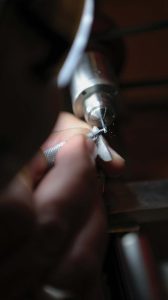
It takes a steady hand to turn this tiny part on a watchmaker’s lathe that was handmade in Kalispell.
Since Berghold opened his doors nearly 35 years ago, The Last Wind-Up has been a sanctuary for watch enthusiasts — a comprehensive timepiece repair, restoration, and retail business in the city’s historic downtown. Visiting the store’s workshop feels like stepping into an entirely new universe, where antique wooden cabinets line the perimeter and watchmaker lathes and microscopes cover the tables. Along with, of course, timepieces. The shop boasts bags and bags of old watches, or “treasure troves,” as Berghold fondly refers to them; neat rows of heirloom watches, sent from all over the country for Berghold to repair; and a selection of new wristwatches from Berghold’s brand, dubbed DB — Dave Berghold.
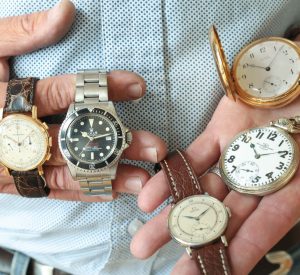
A timepiece connoisseur, Berghold displays some of his personal favorites.
All the pieces Berghold displays are beautiful, but it’s their stories that make them shine. “A watch’s story makes it a living piece of history,” says Berghold. A well-made watch will pass from one wrist to the next, enduring generations of wear. It will be a constant companion on a person’s journey through life, a present for a birthday, wedding, or anniversary. “Owning a watch, you’re its caretaker,” says Berghold. “It’s a part of your life at this moment, but it will continue to pass through time.”
Berghold grew up on the East Coast, in New York City, before moving to Pennsylvania for college. But it didn’t take long for him to realize school wasn’t where he needed or wanted to be. He preferred to spend time learning horology, the study and measurement of time, so he dropped out and found a job — “more of an apprenticeship,” says Berghold — at an antique clock store in London. “I was being paid next to nothing and learning very little, unfortunately, but I was in London. And watch history was everywhere.”
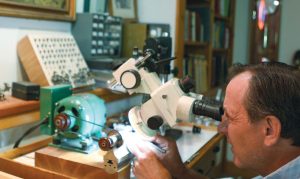
Lathe work under the scope is no small task: Here, Berghold polishes a pivot to a diameter of 0.11 mm.
After a break-in at the shop abruptly ended his London experience, Berghold landed a more formidable internship in the watch department at Christie’s, one of the world’s leading auction houses. Working under Jonathan Snellenburg, a renowned timepiece expert, helped Berghold gain a stronger foundation in the field.
Two years later, after earning a bachelor’s degree at Northeastern, Berghold opened his first timepiece shop in Boston, Massachusetts. “It was a small shop, and I was barely scratching out an existence, but I liked it,” he says. But it wasn’t long before the shop’s landlord decided to sell the building, so Berghold resolved to make a change. His parents were now living in Montana, and on a visit to the state, Berghold got word of a jewelry store for sale in Bozeman. He took a look, made an offer, and that was that. Berghold opened The Last Wind-Up the day after Thanksgiving in 1990.
Repairs, resale, and retail — these are the tentpoles of The Last Wind-Up. But repairs are Berghold’s wheelhouse. Despite the recent surge of interest in collecting timepieces and watch repair, the body of restoration experts who complete it has only grown smaller by the year. “In the 1960s, I’d bet there were dozens of watchmakers in Montana,” says Berghold, “but now there’s just a handful.”
The diminishing pool of experts puts Berghold’s talent in high demand, which is just as well, considering Berghold is passionate about bringing old watches back to life. “The perfect analogy for fixing a watch is seeing an EMT use a defibrillator,” says Berghold. “You set everything in place, carefully and perfectly, then wind up the watch — and watch it dadum, dadum, dadum. Maybe the watch was dead for 10 years, 100 years even, but suddenly it has a beating heart. It’s alive again.”
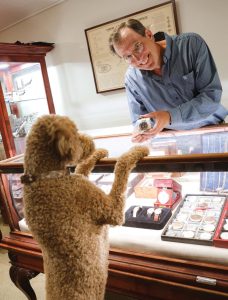
Berghold proudly caters to all customers, even Oscar, the watchdog.
The thrill of a challenge, the satisfaction of finding a solution, and the joy of a happy client keep Berghold in the watch business. “If it’s not clear enough,” Berghold says, gesturing around the tidy workshop, “I love what I do. I was on vacation last week, and I should have been out fishing, but all I wanted to do was start repairing a few watches.”
The Last Wind-Up is a great place to buy your own timepiece, regardless of whether you’re looking for something antique or new. Berghold likes to carry high-quality watches at various prices, making the shop accessible to all types of buyers. And across price ranges, the store’s inventory is a collector’s paradise. For vintage, you can expect rare and unique 20th- to 21st-century models in pristine condition, like a 1940s Gruen, sleek Cartier Tank, exquisite Breguet, classic Omega, or chunky ’90s-era Rolex.

Berghold carefully assembles this 1925-era Art Deco wristwatch movement with singular precision.
The new watches at The Last Wind-Up display Berghold’s reverence for local craftsmanship. The store carries watches from the Tree Ring Co., a western-Montana-based company that uses the inner ring of a tree’s trunk to create the faces of its watches. The company is committed to maintaining the health of Montana’s forests — by cutting down small, younger trees, they help make way for controlled burns. The watches are beautiful mementos of the state, combining its rich history with an enduring reverence for the land.
And then there’s DB — Berghold’s timepiece brand — which he launched in 2021. Berghold’s rich knowledge of watch history, design, and mechanics defines the look and feel of the collection. “I wanted to design a brand that everyone would enjoy,” says Berghold. The result is a collection that is as practical and durable as it is beautiful and timeless. The DB Model 1A is a perfect example. A gorgeous watch characterized by its bison-leather strap and swirling yellow font, Berghold describes, “When I talk about watches being a time capsule, this is what I mean.” He places a watch from his personal collection, circa 1910, alongside the Model 1A, revealing the similarities. The newer watch emulates the look and feel of its predecessor while precisely capturing the mood and influences of early-20th-century style.
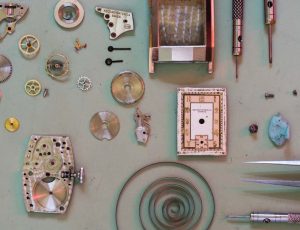
After careful cleaning, this 1925-era watch movement is ready for reassembly.
Each watch in the DB collection is layered with meaning if you know where to look. The DB Model II Field Watch, a functional option for any outdoors enthusiast, offsets the 45-minute marker in red ink, diverging from the model’s black-and-white color palette. “It’s to honor Bozeman,” Berghold explains, “and our spot on the 45th parallel.”
So, what’s the appeal of a mechanical watch? “A lot of people will come into the shop with these old pocket watches that need repairing and ask me what they will fetch on the open market,” says Berghold, “and the answer is usually not much. If you want me to repair it, top to bottom, it could cost about $350 and still only sell for $200.” But he posits the repair is worth the cost because a good watch, well kept, will last longer than any of us. “I tell people, ‘Keep it. Preserve it. Save this watch because someday, you’ll pass it down to someone younger, and its story will continue.’”
The Last Wind-Up is located on the mezzanine level at 11 E. Main St. in Bozeman. To learn more visit lastwindup.com.
Halina Loft is a writer and editor based in Bozeman, Montana. Before moving west, she worked as an arts editor for Sotheby’s in New York City.
Melanie Maganias loves capturing the essence of her subject matter in editorial assignments, at weddings, and in portraits by following her intuition and using her camera as a tool to depict her vision. Named one of America’s Top 15 Wedding Photographers by PDN, her work has been featured in The New York Times, Forbes, Real Simple Weddings, Martha Stewart Weddings, and many other publications. She earned bachelor’s and master’s degrees in photography and has also taught at Montana State University.




No Comments